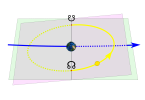Small ball is a term that has been thrown around in the NBA for a while now. It refers to a style of play that prioritizes speed, agility, and versatility over size and strength. The idea is to have a team of players who can switch positions seamlessly and create mismatches on the court.
The small ball strategy gained popularity in the early 2010s with the success of the Miami Heat and the Golden State Warriors. Both teams had smaller lineups that were able to outrun and outscore their opponents. Since then, many teams have adopted the small ball approach, and it has become a staple of modern NBA basketball.
But what does small ball really mean? And how does it work in practice? In this article, we will explore the origins of small ball, its key principles, and its impact on the game of basketball.
Understanding ‘Small Ball’
In the NBA, ‘Small Ball’ refers to a style of play where teams use smaller and more agile players in their lineups to create a faster and more versatile game.
This style of play has become increasingly popular in recent years, as teams look to counter the traditional big-man approach that dominated the league for decades.
The term ‘Small Ball’ can be traced back to the early 2000s, when the Golden State Warriors began experimenting with lineups that featured smaller players. The team’s coach at the time, Don Nelson, is often credited with popularizing the style of play.
One of the key advantages of ‘Small Ball’ is that it allows teams to spread the floor and create more space for their players to operate. This can lead to more open shots, easier drives to the basket, and more opportunities for fast breaks.
To be successful with ‘Small Ball’, teams need to have players who are versatile and can play multiple positions. This means that players need to be able to shoot, pass, and defend at a high level. It also means that teams need to be able to switch on defense, as players will often be matched up against opponents who are bigger and stronger than they are.
Overall, ‘Small Ball’ is a style of play that emphasizes speed, versatility, and skill over size and strength. While it may not work for every team, it has proven to be a successful approach for many of the top teams in the league.
The Evolution of ‘Small Ball’ in the NBA
Over the years, the NBA has seen a significant evolution in its playing style. One of the most prominent changes is the rise of ‘small ball.’
In this style of play, teams prioritize speed, agility, and ball movement over size and strength. This section will explore the evolution of small ball in the NBA.
Small ball gained popularity in the early 2000s when teams like the Phoenix Suns and the Golden State Warriors started using it. The Suns, led by Steve Nash, used a fast-paced style of play that focused on ball movement and outside shooting. Meanwhile, the Warriors, led by Stephen Curry, emphasized quick passes and three-point shooting to create scoring opportunities.
As small ball became more prevalent, teams started using it in different ways. Some teams, like the Miami Heat, used small ball to create mismatches and exploit weaknesses in opposing teams’ defenses. Other teams, like the Houston Rockets, used small ball to play a more aggressive style of defense.
Small ball has also led to changes in player positions. Traditionally, players were assigned positions based on their size and skill set. However, in small ball, players are often assigned positions based on their versatility and ability to play multiple positions.
Overall, small ball has become a popular style of play in the NBA due to its emphasis on speed, agility, and ball movement. As the NBA continues to evolve, it will be interesting to see how small ball continues to develop and impact the game.
Benefits of ‘Small Ball’ Strategy
Faster Pace of Play
Small ball strategy usually involves playing with smaller, quicker players, which leads to a faster pace of play. This can help to tire out the opposing team and create more scoring opportunities. With smaller players, teams can move the ball up the court more quickly, leading to a more dynamic and exciting game.
Increased Scoring Opportunities
Small ball strategy can create more scoring opportunities by spreading the floor and opening up driving lanes. With smaller players, teams can also shoot more three-pointers, which can lead to more points on the board. Additionally, smaller lineups can be more versatile, allowing teams to switch defensively and disrupt the opposing team’s offense.
Overall, small ball strategy can be an effective way to create a faster-paced, more dynamic game with increased scoring opportunities.
However, it is important to note that this strategy may not work for every team and every situation. Teams must carefully consider their strengths and weaknesses before implementing a small ball strategy.
Disadvantages of ‘Small Ball’ Strategy
Defensive Challenges
One of the main disadvantages of small ball is the defensive challenges it presents. When teams go small, they sacrifice size and strength in the paint, which can lead to problems defending against bigger and stronger opponents. This can be especially problematic when it comes to defending against post players or centers who are skilled at scoring in the paint.
Additionally, smaller lineups can struggle to defend against pick-and-roll plays, which can create mismatches and leave defenders out of position. This can lead to easy baskets for the opposing team and put pressure on the offense to keep up.
Rebounding Difficulties
Another disadvantage of small ball is the difficulty in rebounding. With smaller players on the court, there is less size and strength to compete for rebounds. This can lead to giving up second-chance points to the opposing team and limit the number of opportunities for the offense.
In addition, smaller lineups may struggle to defend against offensive rebounds, which can create additional scoring opportunities for the opposing team. This can be especially problematic when facing teams with strong rebounding centers or power forwards.
Overall, while small ball can be an effective strategy in certain situations, it also presents significant challenges on both the offensive and defensive ends of the court. Teams must carefully consider the strengths and weaknesses of their players and opponents before deciding to employ this strategy.
Prominent ‘Small Ball’ Teams in NBA History
Small ball has been a popular strategy in the NBA for many years. Here are a few of the most prominent small ball teams in NBA history:
Golden State Warriors (2015-2019)
The Golden State Warriors are perhaps the most famous small ball team in NBA history. Their starting lineup often featured four guards and one center, with Draymond Green playing the role of the “small ball” center. This lineup was incredibly effective, winning three NBA championships in four years.
Miami Heat (2012-2014)
The Miami Heat used small ball to great effect during their championship runs in 2012 and 2013. They often played LeBron James at power forward and Chris Bosh at center, with a lineup that emphasized speed and shooting.
Phoenix Suns (2004-2008)
The Phoenix Suns were known for their “seven seconds or less” offense, which relied heavily on small ball. They played with a fast pace and emphasized three-point shooting, with Steve Nash leading the way at point guard.
Houston Rockets (2017-2019)
The Houston Rockets have been a small ball team in recent years, often playing without a traditional center on the court. Instead, they rely on a lineup of versatile players who can shoot and defend.
Overall, small ball has become an increasingly popular strategy in the NBA, and these teams are just a few examples of its success.
Impact of ‘Small Ball’ on Modern NBA
Small ball has had a significant impact on the modern NBA, changing the way teams approach the game both offensively and defensively. The rise of small ball can be attributed to several factors, including an increased emphasis on three-point shooting, the growing importance of versatility, and the need to counter the dominance of big men in the league.
Offensively, small ball has allowed teams to spread the floor and create more open looks from beyond the arc. This has led to an increase in three-point attempts and a higher overall scoring output. Teams that have embraced small ball have also been able to play at a faster pace, using their speed and agility to create open shots in transition.
Defensively, small ball has allowed teams to switch more effectively on pick-and-rolls and other plays, making it harder for opposing teams to exploit mismatches. This has also led to an increase in steals and turnovers, as smaller, quicker defenders are able to disrupt passing lanes and create turnovers.
While small ball has its advantages, it is not without its drawbacks. One of the biggest challenges teams face when playing small ball is rebounding. With smaller lineups, teams are often at a disadvantage when it comes to securing rebounds, which can lead to second-chance points for the opposing team.
Overall, the impact of small ball on the modern NBA has been significant, with many teams adopting this style of play in order to keep up with the changing landscape of the league. As the NBA continues to evolve, it will be interesting to see how teams continue to adapt and innovate in order to stay ahead of the curve.







